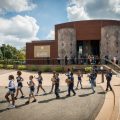A year outside the museum walls
Melanie Adams, director of the Anacostia Community Museum, reflects on the challenges of bringing the museum outside when COVID prevents visitors from coming inside.

Celebration Sept. 15, 2017. (Photo by Susana Raab / Anacostia Community Museum)
In 2021, as the country continued to grapple with the health effects of COVID and the legacy of racial inequality, the Anacostia Community Museum took the streets of D.C. to tell the stories of those furthest from justice and the organizations and individuals trying to make a difference. Instead of looking for inspiration inside of our walls, the museum turned outward and found a way to make the city our museum in a way that was innovative and COVID-safe.
In February 2021, the museum installed “Men of Change: Taking it to the Streets in the Deanwood neighborhood. With the assistance of community partners such as the Ron Brown School for Boys, the Deanwood Recreation Center, Deanwood DC, and the Deanwood Citizens Association, the museum placed its first outdoor exhibit. This exhibit, focusing on the lives of African American men, reminded visitors that the lives of African American men are complex and an important part of the American narrative from literature to politics to sports. Visitors to the exhibit expressed appreciation for seeing men from the community being recognized as everyday heroes and having the exhibit outside expanded access to people who may not visit museums.

Building upon the success of “Men of Change: Taking it to the Streets,” the museum’s next outdoor exhibit was “Food for the People: Eating and Activism in Greater Washington,” located on the museum plaza. This exhibit focuses on the people and organizations that are working to eliminate food inequality in the region which was exacerbated by the ongoing pandemic. The exhibit visually demonstrates the grocery store gap and the level of food waste in the country alongside the people working tirelessly for change.

The outdoor exhibit is one part of the story. The second part of the exhibit opened inside the museum in August and focuses on the legacy of food inequality and what people can do today to help build a more equitable system for all. Divided into five sections, the exhibit tells the stories of everyday people advocating for their rights to healthy and affordable food. With a focus on the food system, the exhibit exposes the inequalities designed into the system and at the end of the exhibit, encourages visitors to reimagine the components of a just food system.As the country continues to acclimate to a new normal, the museum plans to continue to work with community partners and to find ways to take our programs outside of the museum walls. In February 2022, the museum will unveil a new outdoor projection system that will allow us to project images on the museum walls. We added new educators who will work both on-site and out in the community developing programs. In March, we will release a new online exhibit looking at the history of Barry Farms/Hillsdale and the importance of housing to African American communities. Over the summer, we will release a virtual reality experience in the Southwest neighborhood that looks at the change in the neighborhood over time.
For almost 54 years, the Smithsonian’s Anacostia Community Museum has served the people of the Washington region by telling the stories of ordinary people doing extraordinary things. We have focused on those furthest from justice and how they advocated to secure rights that most people take for granted such as access to healthy food, clean water, and quality schools. We brought to light people that have always been doing the work but were relegated to the background.
This post by ACM DIrector Melanie A. Adams was originally published Dec. 20, 2021 by the Washington Informer. Reprinted with permission.
Posted: 13 January 2022







